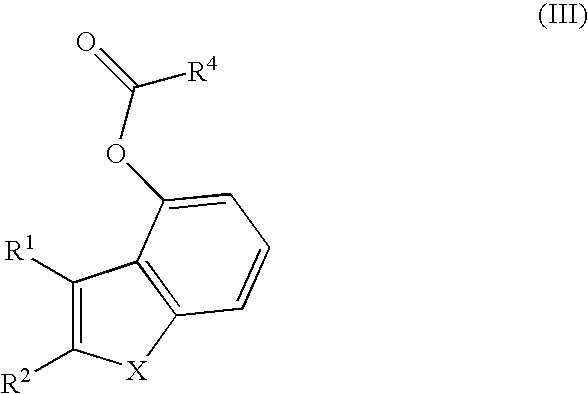Process for preparing heterocyclic indene analogs
a heterocyclic indene and analog technology, applied in the field of new heterocyclic indene analog preparation process, can solve the problems of high high temperature and achieve the effect of low catalyst loading and modest selectivity, and high catalyst loading and selectivity
- Summary
- Abstract
- Description
- Claims
- Application Information
AI Technical Summary
Benefits of technology
Problems solved by technology
Method used
Image
Examples
example 1
1-(1-Benzenesulfonyl-1H-indol-2-yl)-allyl Alcohol
[0136]10.3 g (40 mmol) of 1-(phenylsulfonyl)indole (synthesized analogous to T. Sakamoto; Y. Kondo; N. Takazawa; H. Yamanaka; J. Chem.Soc.Perkin Trans. 1; 16; 1996; 1927–1934) in 110 ml tetrahydrofuran were cooled to −20° C. To the stirred solution 30 ml of 1.6 M n-butyllithium were added at −20° C. within 20 min. The resulting suspension was warmed to 10° C. and stirred at 10° C. for 4 hours. The mixture was again cooled to −20° C. and a solution of 3.4 g acrolein (61 mmol) in 20 ml THF was added dropwise within 20 min at −20° C. The solution was stirred at 20° C. for 16 hours. 150 ml water was added dropwise, the mixture was vigorously stirred for 10 min. The phases were separated, and the water phase was extracted with 3×100 ml of methyl-t-butyl-ether. The combined organic phases were washed with 100 ml of brine, dried on sodium sulfate and rotary evaporated (35° C., 20 mbar). The residue was purified by liquid chromatography (elue...
example 2
Acetic Acid 1-(1-benzenesulfonyl-1H-indol-2-yl)-allyl Ester
[0139]To a solution of 19.1 g of 1-(1-benzenesulfonyl-1H-indol-2-yl)-allyl alcohol (74 mmol) in 244 ml dichloromethane were added 34 ml triethylamine and 0.7 g 4-dimethyl-aminopyridine. The solution was cooled to 3° C. To the magnetically stirred solution 23.5 ml of acetic anhydride qas added with a dropping funnel at a temperature below 5° C. The reaction mixture was stirred 2 h at 22° C. After cooling in an ice bath 250 ml of water was added at a temperature of 20 to 24° C. The mixture was vigorously stirred for 10 min. The phases were separated, and the water solution extracted with 250 ml of dichloromethane. The combined organic phases were extracted with 250 ml of water three times, and once with 250 ml of brine. The dichloromethane solution was dried on sodium sulfat and finally rotary evaporated (35° C., 50 mbar), yield 22.8 g. In the next step (the cyclocarbonylation) the resulting oil was used without purification (...
example 3
Benzoic Acid 1-(1-benzenesulfonyl-1H-indol-2-yl)-allyl Ester
[0141]To a stirred solution of 10.0 g of 1-(1-benzenesulfonyl-1H-indol-2-yl)-allyl alcohol (32 mmol) in 100 ml of pyridine were added dropwise 5.6 ml benzoyl chloride (48 mmol) at 10° C. The mixture was stirred for an additional 1 h at 20° C. Most of the pyridine was distilled off, the residue was given in portions to 300 ml of ice water. The pH was adjusted to 2–3 with conc. HCl. The water was distilled off and the residue was dissolved in 100 ml of diethyl ether. After about 1 h the product crystallized. The suspension was stirred in an ice bath for 2 h, the solid was filtered off. The crude material was recrystallized from 90 ml methanol and dried 12 h at 35° C.
[0142]Yield: 5.2 g (39%) HPLC 98.4 Area-%, m.p. 112–114° C.
[0143]1H NMR (δ, DDMSO): 7.19 (CH—O, d), 6.35 (CH═CH2, ddd), 5.44 (CH═CH2, dd), 5.48 (CH═CH2, dd), aromatic signals at 7.0–8.1.
PUM
 Login to View More
Login to View More Abstract
Description
Claims
Application Information
 Login to View More
Login to View More - R&D
- Intellectual Property
- Life Sciences
- Materials
- Tech Scout
- Unparalleled Data Quality
- Higher Quality Content
- 60% Fewer Hallucinations
Browse by: Latest US Patents, China's latest patents, Technical Efficacy Thesaurus, Application Domain, Technology Topic, Popular Technical Reports.
© 2025 PatSnap. All rights reserved.Legal|Privacy policy|Modern Slavery Act Transparency Statement|Sitemap|About US| Contact US: help@patsnap.com



